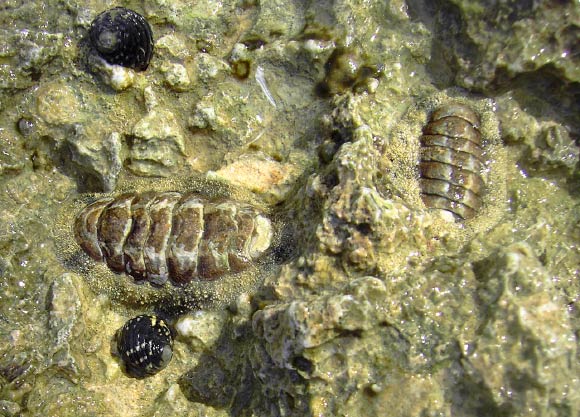Marine biologists have long known that armored mollusks called chitons have hundreds of small eyes dotting the surface of their hard turtlelike shells. Now new research, published in the journal Science, shows that these eyes – called ocelli – are true eyes, capable of forming focused images.

Two West Indian fuzzy chitons (Acanthopleura granulata). Image credit: Hans Hillewaert / CC BY-SA 4.0.
Chitons – the only mollusks with living tissue in their shells – resemble prehistoric trilobites and are about the size of a potato chip. They are found in many parts of the world, but are little noticed.
Unlike most mollusks, their shells are made of eight overlapped plates, which allow them some flexibility.
Since these creatures live in the intertidal zone – meaning they are sometimes underwater and sometimes exposed to air – their eyes, which are each less than a tenth of a millimeter across, need to be able to work in both environments.
“Mineral-based eyes allow the animal to monitor its environment with the protective armor shell. The majority of the shell is opaque, and only the eyes are transparent,” explained study’s lead author Ling Li, of Harvard University and the Massachusetts Institute of Technology.
Specifically, Li and co-authors studied the West Indian fuzzy chiton (Acanthopleura granulata).
Unlike the eyes of almost all other living creatures, the eyes of this and other chiton species are made of the mineral aragonite, the same ceramic material as the rest of the creatures’ shells.
Recent research has suggested that the West Indian fuzzy chiton may be capable of spatial vision.

Close-up image of the shell of the West Indian fuzzy chiton (Acanthopleura granulata) shows the two kinds of sensory organs that cover the shell surface: the eyes are the dark bumps with shiny centers; the exact function of other sensory organs called aesthetes – small bumps with black centers – is not yet known. Image credit: Ling Li et al.
Li and his colleagues performed optical experiments on individual isolated chiton eyes in the shell to demonstrate that these microscopic lenses are able to form images.
This allows the chitons to visualize and quickly respond to approaching predators — clamping to the substrate below them so that they cannot be dislodged from it.
“A lot of people thought the eyes were so small, there was no way this small lens would be capable of forming an image. But we isolated some of these lenses and were able to produce images,” said co-author Matthew Connors from the Massachusetts Institute of Technology.
The results also reveal that as the size and complexity of individual chiton eyes increases, the local mechanical performance of the armor decreases – highlighting the trade-off between the two tasks.
_____
Ling Li et al. 2015. Multifunctionality of chiton biomineralized armor with an integrated visual system. Science, vol. 350, no. 6263, pp. 952-956; doi: 10.1126/science.aad1246







